Primitive reflexes are automatic movements that are directed by the brainstem and need no cortical involvement (thought). They are essential for survival and development in the womb and in the early months of life until they become obsolete when higher functioning brain processes take place. At this point, they need to be inhibited or the proper neurological organization of the more sophisticated centers of the brain do not develop.
We know from previous child development research that children’s brains are not capable of processing things in the same way as adults. Children are sensory creatures, and their brains develop from the bottom up.
That means there is a highly organized way in which the brain interprets information and how children acquire skills.
There are 70 known primary reflexes.
Each reflex is associated with one or more of the Sensory Processing Systems:
- Auditory
- Taste
- Tactile
- Smell
- Visual
- Vestibular
- Proprioceptive and/or
- Interoceptive.
If retained, a child may experience dysfunction within one or several of the sensory processing systems which can lead to sensory processing disorder.
Let’s look at the pyramid of learning. As you can see, the foundation of the pyramid houses all our sensory systems. Children interpret the world through their senses. When they are born, these senses are underdeveloped, and they have primitive reflexes that help them navigate the world.
Gradually, these primitive reflexes are integrated and replaced with higher level learning. Jerky, primitive movements become smoother, and the brain is better able to comprehend more difficult concepts.
If the development of these sensory systems is compromised, then that affects learning that comes in the more advanced sections of the pyramid.
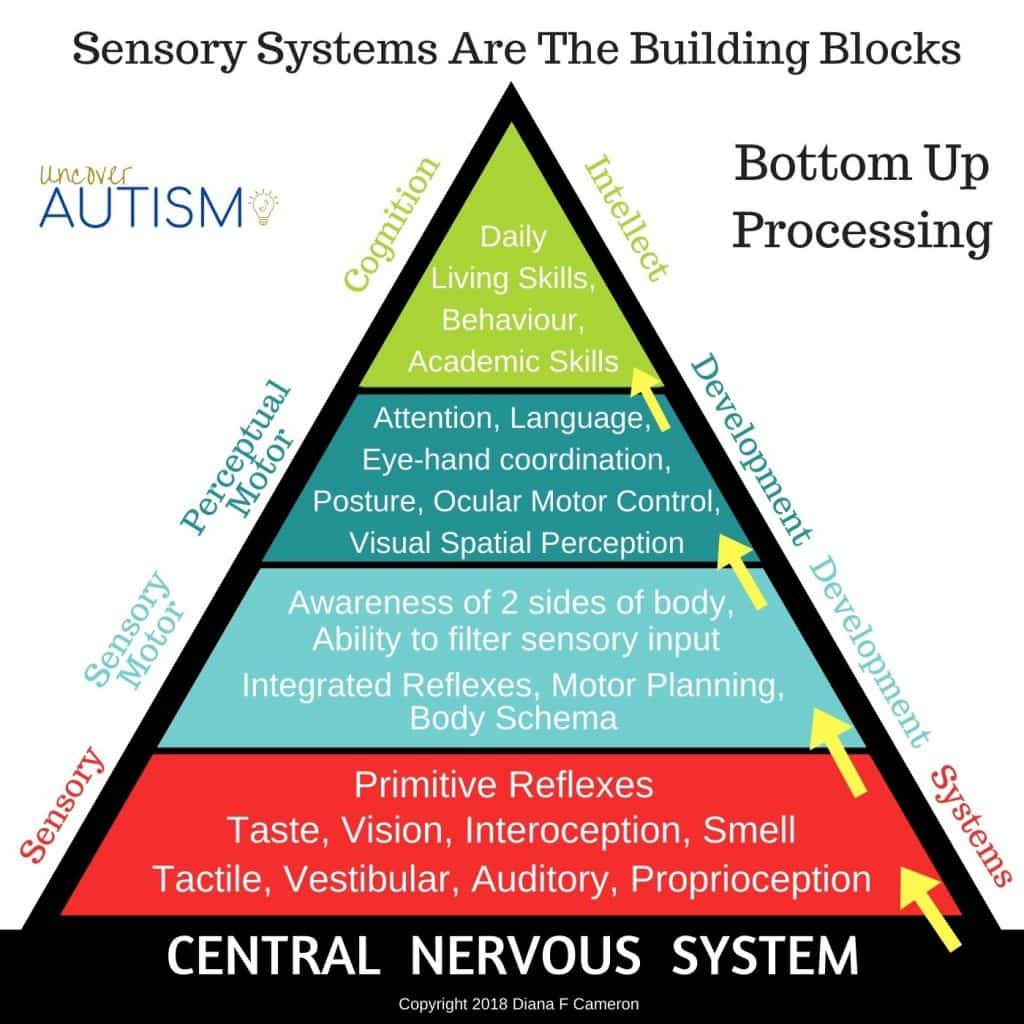
As we know, most children with autism have challenges in this sensory area. It may be auditory processing disorder, sensory issues where they crave movement, or detest movement.
They may be picky eaters who only eat certain foods or may be hard to potty train. All of these challenges stem from problems in this first foundational section.
The problem is, for many neurodivergent children, because of their sensory processing challenges, they retain some of these primitive reflexes.
You don’t have to be neurodivergent to have retained primitive reflexes, but many children with autism have this issue.
Their lack of integration can cause all sorts of issues for children down the track. I have seen teenagers struggling at school with learning who have tested positive for retained primitive reflexes. When certain exercises are done to integrate these flexes, learning improves.
We use a 12 week program that can be done in the safety and privacy of your home. It is as simple as logging on and following videos of other children doing the exercises. They only take about 20 minutes a day, 5 days a week. After 12 weeks, we usually see improvements. The program is for children 8 – 12 years, but we have used it in children as young as 6 years with success and children up to 15 years.
What are Primitive Reflexes?
Primitive reflexes are automatic movements that are directed by the brainstem and need no cortical involvement (thought). For example, fight or flight.
They are automatic responses just like fight or flight. They are essential for survival and development in the womb and in the early months of life until they become obsolete when higher functioning brain processes take place. At this point, they need to be inhibited or the proper neurological organization of the more sophisticated centers of the brain do not develop. There are 70 known primary reflexes.
Each reflex is associated with one or more of the Sensory Processing Systems.
Possible Causes of Retained Primitive Reflexes
- Cesarean section – while it can’t be avoided in many instances (and I was one of those cases with a baby that was transverse the entire pregnancy), it worries me when more specialists are booking C section births because it is convenient and easier to plan around. If at all possible, the natural birth experience triggers a lot of developmental functions and having a cesarean birth can be one piece of a larger puzzle with some children.
- Trauma
- Toxicity exposure
- Anesthetics
- Insufficient tummy time
- Lack of or little creeping or crawling on all 4s
- Early walkers – who haven’t crawled enough
- Head injuries
- Excessive falls
- Chronic ear infections
Nature has provided a way for babies to be born that stimulates the top of the head (and the senses) as they come down the birth canal. It should never be done out of convenience and, if at all possible, a natural birth experience is optimal as it triggers developmental processes.
As I stated, there are occasions where it is necessary and if that is the case, then work needs to be done working with the baby afterwards to provide some of that stimulation that was missed during the birth process.
Please Note: just because a child has gone through one of these things does not mean they have retained reflexes, but when coupled with a broader knowledge of what is happening with the child you may start to see a pattern.
What Can be Done to Help Retained Primitive Reflexes?
As you will see below, there are some suggestions on how to help retained reflexes. However, it takes someone trained in primitive reflexes to assess which ones your child may be retaining.
While these are great suggestions, my primary suggestion would be to use the movement program that we use and use these other suggestions to support that learning.
The reason for that suggestion is that the program will integrate major and a variety of retained reflexes that will help your child even if you are not aware which ones they need help with.
To find this program, go to https://movementprogram.com/ and use the code DAcheson when signing up to get a discount.
Possible Challenges if Primitive Reflexes are Retained:
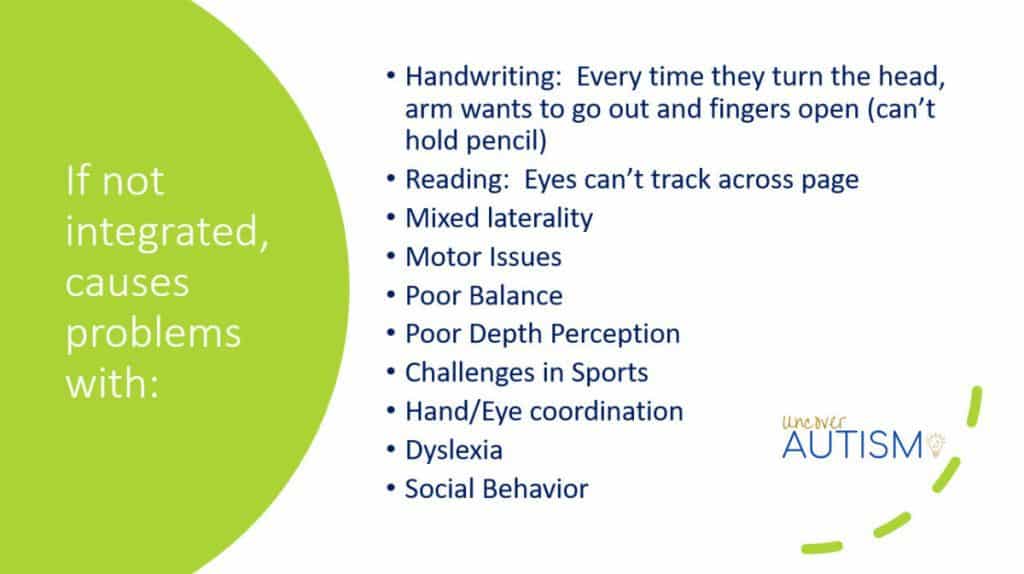
There are many things that can be affected in children with autism by retained reflexes and things that you might not associate with this issue. These are the symptoms that might appear because of a TLR reflex – just one of the 70 that we have.
The challenges can be (but not limited to):
- Poor muscle tone, fatigues easily when lifting arms
- Head appears heavy, tilts head to side or front
- Poor balance when looking up or down, walking up or down stairs can be difficult
- May experience motion sickness, vertigo, fear of heights
- Child may exhibit mixed dominance; interchanges use of left/right hand/foot/eye for same tasks
- May have difficulty with cross-lateral skills causing coordination problems, stiff jerky movements
- Poor spatial awareness, child is disorganized, forgetful
- Poor auditory processing, challenged with multiple instructions and verbal learning
- Poor sequencing skills, effects speech
- Poor eye movement (difficulty crossing midline), possible crossed eyes
- Poor visual perception
- Poor spatial perception, difficulty judging space, direction, distance
- Child may appear disconnected to feelings, frustrated, low self-esteem, lack of interest in schoolwork
- Unable to understand cause and effect
It’s All Connected – But the Light Doesn’t Come On

Think of a lamp. The lamp is perfect, the bulb is perfect, the wire running to the wall is perfect. The plug is perfect and the socket in the wall is perfect and electricity is going to the plug. All components on their own are working. Imagine the plug shrinks to half it’s size.
Now try to plug into the wall to have that electricity transfer so there can be light. There is no way we can get the electricity from the wall into the bulb to turn on.
Having retained primitive reflexes in a brain with autism is like that. Children possess all the components they need to learn easily, but there are blocks in the way stopping the information from connecting with other areas that complete cortical functions.
We need to remove the blocks and retrain the brain for the information to flow freely.
Challenges That Can be Seen with Retain Primitive Reflexes
As we can’t look at all the possible retained primitive reflexes, let’s take a look at 3 main ones that are often the cause of many learning challenges.
Asymmetrical Tonic Neck Reflex (ATNR)
A common retained primitive reflex that causes issues with learning is the Asymmetrical Tonic Neck Reflex (ATNR).
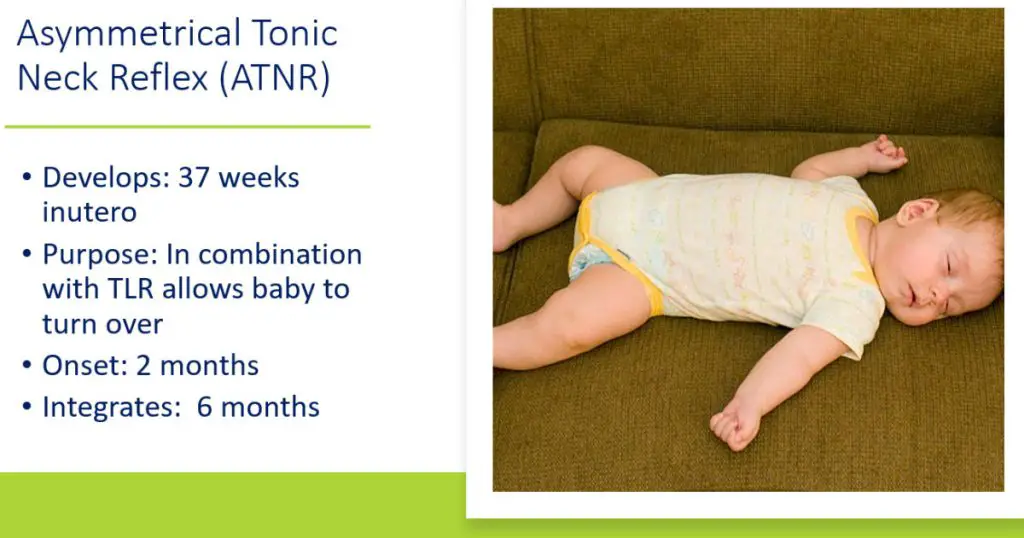
We can see the ATNR reflex at work when a baby turns its head to one side and the limbs on that side straighten. The limbs on the other side bend or flex. ATNR should be integrated and switched of at six months of age.
I have seen many teenagers struggling at school with a retained ATNR.
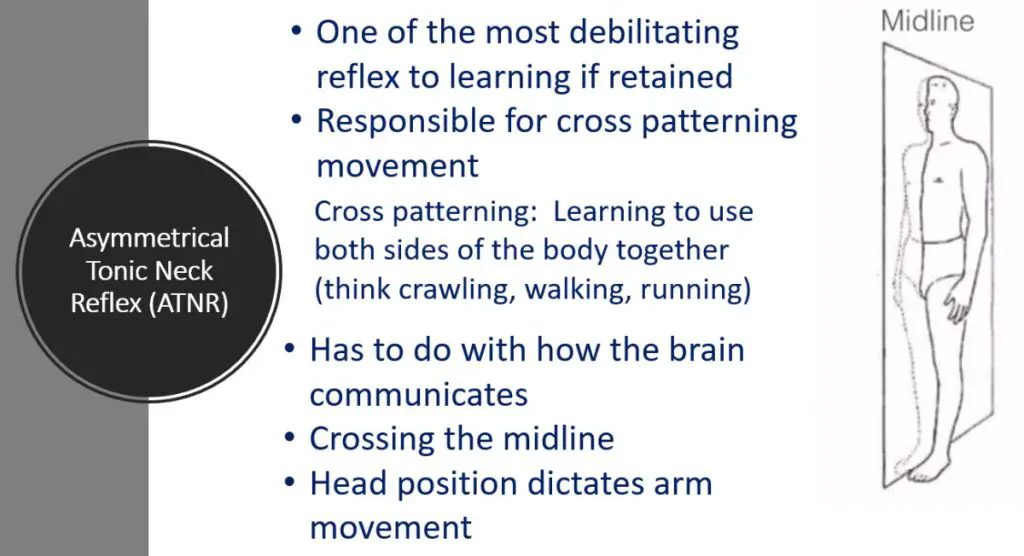
The retention of this reflex causes the most interference with a child’s learning process. It is responsible for:
- Cross patterning movement
- Crossing the midline: When babies are born, they have a midline. This is like an imaginary line in the brain that cannot be crossed until it is dissolved (integrated).
If you watch a baby, they will pick something up with one hand and transfer it to the other – they will not cross over the body. This is a problem on many fronts like reading (eyes need to cross the page) and children with a retained ATNR will blink when they get to the midline before reading the rest of the line. Also, to understand the world around us we need information to cross from one hemisphere to the other. That is crossing the midline as well.
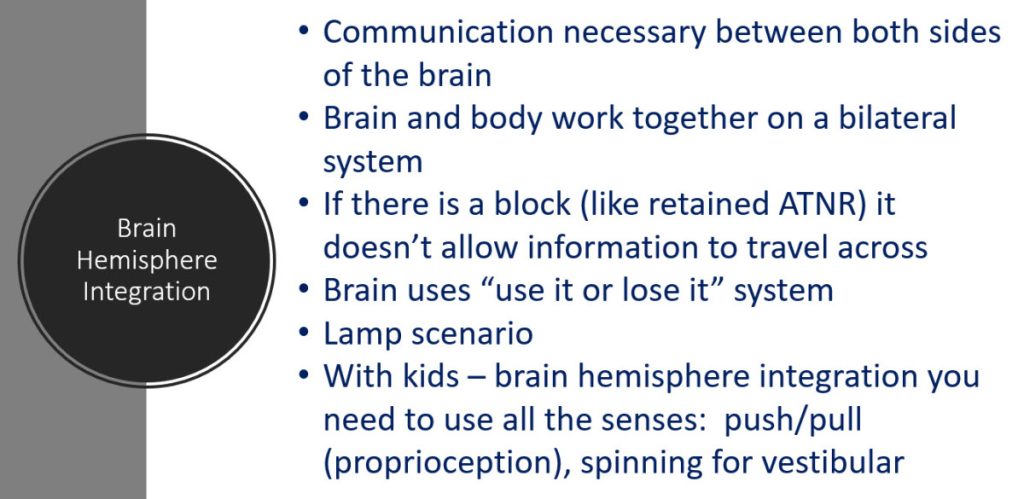
BRAIN HEMISPHERE INTEGRATION
If a child retains this reflex, it stops the two hemispheres of the brain being able to talk to each other. This causes huge issues because:
- The brain and body work together on a bilateral system. Information that enters the body on the right side (ear, hand, eye etc) is passed across to the left side of the brain and vice versa). If there is a block (like retained ATNR) it doesn’t allow information to travel across. So now the information is not getting to where it needs to go. The brain is clever and the other side will try to deal with it, but it is also impatient and after awhile it will work out that the system isn’t working
- Brain uses a “use it or lose it” system so after time if the information is no longer going to that side of the brain, it decides it won’t use it anymore and that side becomes weak. The other side that is trying to deal with everything becomes dominant and there is no balance in the brain. Brains out of balance have a massive communication problem which shows in behavior and skills.
- Lamp scenario – pretend you have a standard lamp. The lamp is perfect, the bulb is perfect, the wire running to the wall is perfect. The plug is perfect and the socket in the wall is perfect, and electricity is going to the plug. All components on their own are working. Imagine the plug shrinks to half its size. Now try to plug into the wall to have that electricity transfer so there can be light. There is no way we can get the electricity from the wall into the bulb to turn on.
- With kids to accomplish brain hemisphere integration you need to use all the senses. For example: push/pull (proprioception), spinning for vestibular (bilibos and twirling), vision exercises (visual tracking), looking down and up when crawling,
We don’t want to push kids past where they are comfortable, but we do want to challenge them so the brain can form new neural pathways.
A retained ATNR can be responsible for problems with:
- Handwriting: Problems with handwriting is the most obvious casualty of the retained ATNR – each time a child turns his head to look at the page, his arm will want to extend and the fingers will want to open. Holding and working a pen or pencil for any length of time will require enormous effort. This leads to a very heavy pencil grip and tension in the body. All the energy is now going into the writing and distracts attention from the writing content. Some children learn to compensate with an immature pencil grip. Writing may slope in different directions from one side of the page to the other so the child may rotate the page as much as 90 degrees when writing in an attempt to “accommodate” the effect of ATNR. Fluent expression of ideas in written form may show a marked discrepancy from the child’s ability to express themselves orally
- Reading: Eye tracking difficulties – when reading the eyes do not move smoothly from one side of the page to the other, they frequently jump. This can result in losing your place, loss of accuracy and loss of comprehension.
- Mixed Laterality: – The child may use left foot, right hand, left ear or child may use left and right hands interchangeably for the same task. The effect of mixed laterality can be failure to send information to the most efficient center of the brain for that skill. Competition between two centers may occur, which is like two people trying to drive the same car. If you can’t cross midline, it causes the body to stop there, or skip or jump there. (eg reading)
- Dyslexia: Their barrier is a little different – the brain becomes like a mirror (so letter reversals). They can’t tell right from left, or spatial orientation
- Social Behavior: If I child is living predominantly in one side of the brain, it shows in social interactions. For example: if they are left brain dominant, they will be very detail oriented. They will play with Lego for hours with no interaction, obsessed with a particular subject, and have difficulty with social interactions.
Social behavior is affected because the right side of the brain is responsible for facial recognition. Therefore, they don’t understand social cues. So, if they are living in the left side of the brain, they don’t understand the social graces they need to make friends and get on in the world (neurodivergent kids).
If they live predominantly in the right side of brain, they will be creative and big picture people. These kids will lack the structure that the left side of the brain gives them.
What can we do to integrate retained primitive reflexes?

To integrate any retained integrated reflex, it takes specialized movements, carefully crafted to integrate those reflexes that have been retained. The best program we have found, which is easy for parents to implement (can be done at home) and the best price for results is The Movement Program.
The Movement Program (TMP) is a series of videos where children can follow along for 20 mins a day, 5 days a week, which integrates retained reflexes. To see a demonstration of the first day, follow along and see how easily it can be done click here.
For only USD$224.95 for the full 12 week program, your child will be well on the way to integrating reflexes which may be impeding learning and growth.
What can we do to integrate an ATNR?
Children with a non-integrated ATNR reflex will also profit from games that help to develop hand-eye coordination and fine and gross motor skills. Helpful games include sorting things, threading pearls onto strings, throwing, marching, catching, aiming, finger games, clapping games, drawing and dancing.
NB: If the ATNR is retained, a child will not be able to cross the midline easily. You need to integrate this first before tackling more difficult tasks.
This would be anything that crosses the body. Things like tapping the elbow, swishing a scarf across the body etc. Here are some other ideas.
- Rolling
- Playing instrument to the side
- Tapping elbow with bells
- Swishing scarves
- Crawling
- Eye tracking
- Drawing a figure 8 using arms or legs
- Counting things in a line with the same hand (crossing the body). A child with retained ATNR will often line them up in a line going out from the body rather than across so they don’t have to cross the midline.
- Drawing large circles in the air with arms (across body)
- Shaking something to the side
- Tapping elbow with the other hand
- Swishing something across the body (eg scarves)
- Crossing arm and tapping shoulders
- Twisting (put arms out when twisting)
- Pretending to sleep (both hands together under your cheek
Where Can I Get More Information?

To find out more about retained primitive reflexes, you can read about two other major reflexes I often see retained (the Symmetrical Tonic Neck Reflex (STNR) and the Tonic Labyrinthine Reflex (TLR) and strategies to help implement them, see our latest book on Autism.
Available in a Kindle ebook and also paperback, you will learn more about what other challenges sensory issues create.
